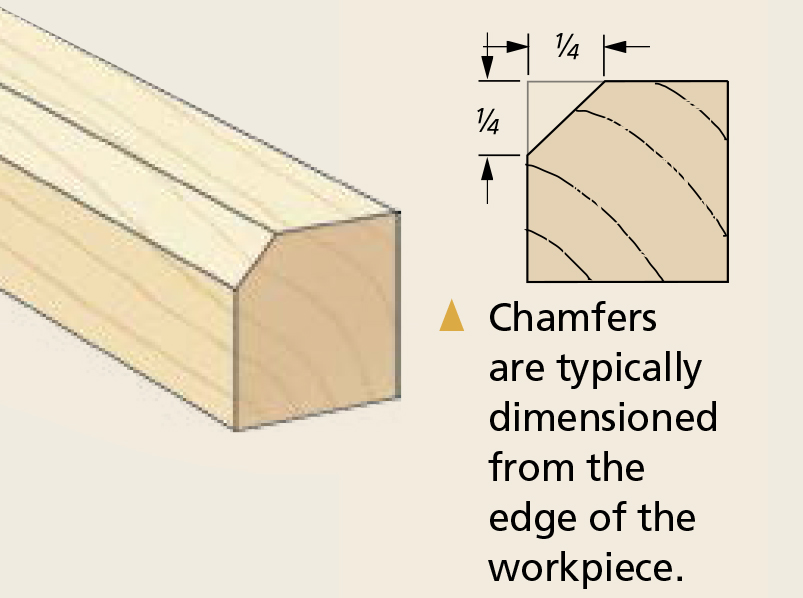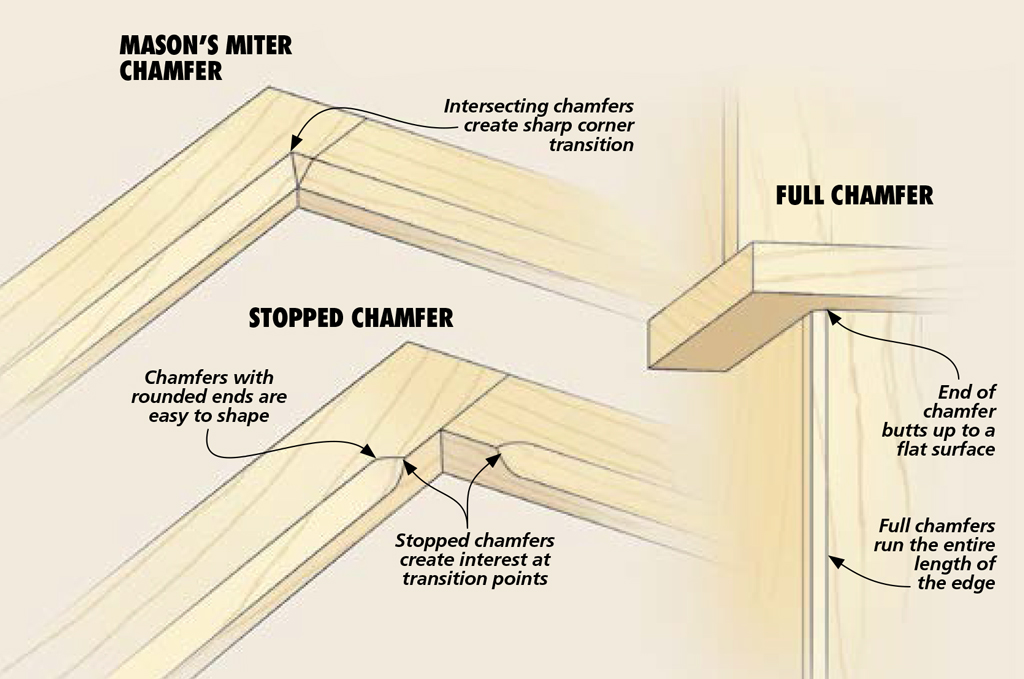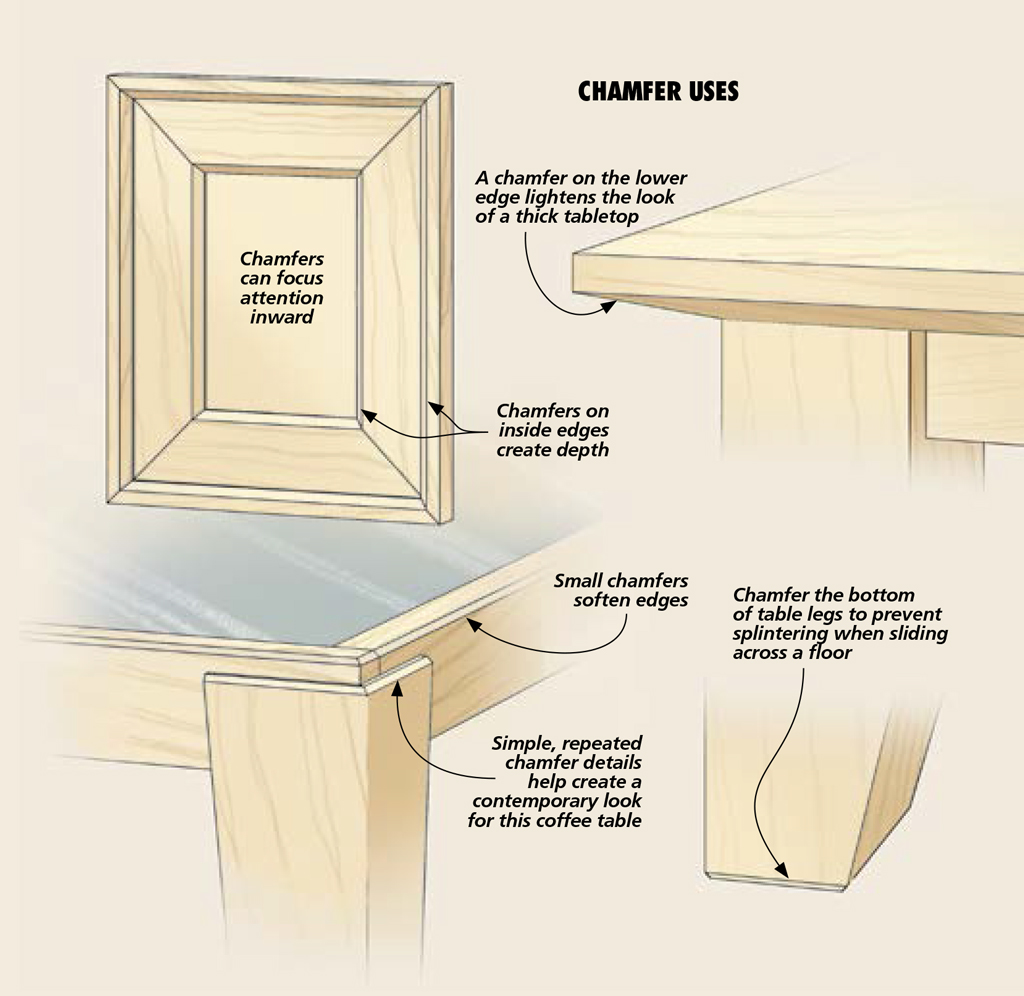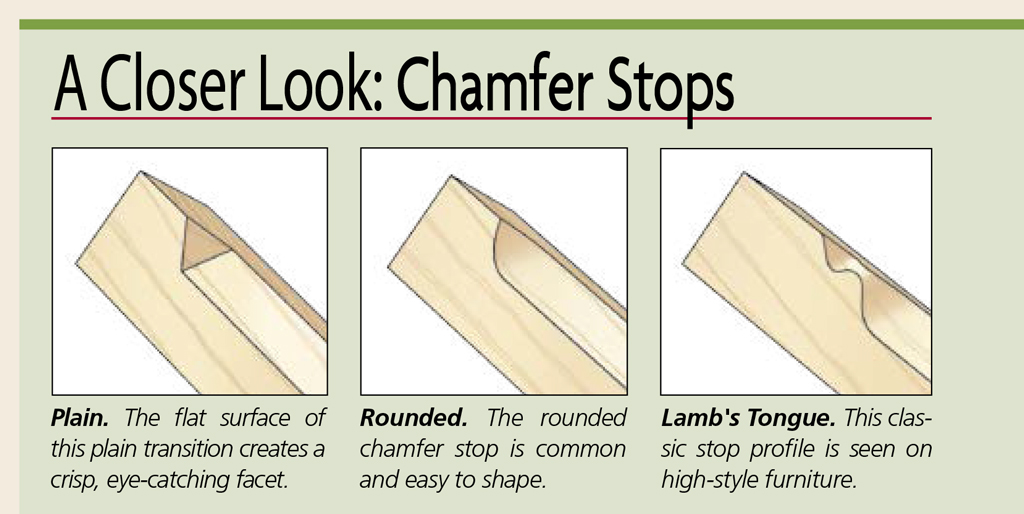
Molding profiles are often pretty style specific. For example, you wouldn’t shape a fancy ogee profile on the edge of Shaker tabletop. However, there is one profile that works on virtually any period or style of furniture — the simple chamfer. No other profile offers as many design uses and possibilities. The trick is knowing how to incorporate chamfers into a design for the best practical function and aesthetic result.

WHAT’S A CHAMFER? Let’s start with the basics. A chamfer is essentially a bevel cut along an edge or across a corner, as shown in the drawing above. Although a chamfer doesn’t have to be cut at 45° to the adjacent surfaces, this is the most common angle. A flat profile cut at a shallower angle is often simply referred to as a bevel. But there’s no rigid distinction between the two terms. A chamfer is usually dimensioned along the relieved edges, not across the face. As shown in the drawing above, a 1 ⁄ 4 " chamfer is formed by cutting back 1 ⁄ 4 " along each edge.
The simple profile of a chamfer is one reason why it’s so versatile — it’s very easy to shape. A chamfer can be made with a variety of hand tools (block plane or spokeshave), it can be routed, or cut on the table saw.

STOPPED OR FULL. Not all chamfers are the same. The drawings above show variations in the way a chamfer can be worked on an edge or edges. A full chamfer runs the entire length of an edge. It either ends free or butted up to a flat surface, as shown below. This type is often a good choice on outside edges.
However, full chamfers can also be shaped on the inside edges of a frame. As you see in the upper left example, the intersecting chamfers are joined with a mason’s miter to form a sharp, square transition.
A chamfer can also stop short of one or both ends of the piece, in which case it’s called a stopped chamfer. Stopped chamfers are often shaped on the inside edges of frames. And they’re used on the outside corners of a case where a continuous chamfer might interfere with other intersecting moldings.
Another reason to use stopped chamfers is the design possibilities. The transition from the square edge to the chamfer can create a focal point for embellishment. The box at the bottom of this post shows several different ways to transition a chamfer.
WHY A CHAMFER? Chamfers can be added to a project to fill a number of roles. I’ll give you some insight into just a few ways your projects may benefit from their use. The drawings below help illustrate these points.

DAMAGE CONTROL. Sharp outside corners on a project are vulnerable to chips, dings, dents, or other abuse. Adding a small chamfer (as little as 1 ⁄ 16 ") to ease the edge is often the answer. For example, the chamfer around the very bottom of the table leg shown at the far right helps minimizes damage when sliding the table across a floor.
Easing sharp edges with a small chamfer has another added benefit. The chamfer helps soften the edge to the touch, such as on a tabletop or drawer front.
FOR APPEARANCE SAKE. A chamfer may also be used like any other profile to add visual detail to an otherwise plain, square edge. Many of the projects you see in Woodsmith feature chamfers shaped for this reason. Chamfers that are 1 ⁄ 4 "-wide and up become focal points that play a role in the overall style of a project.
Keep in mind that the larger the chamfer, the more noticeable it will be. So it’s important to scale the chamfer for the desired affect — subtle or bold.
CRISP & CLEAN. The crisp, unfussy appearance of a chamfer profile makes it a good fit with contemporary designs, as illustrated by the coffee table above. The sharp lines and flat surface add detail that complements a clean, uncluttered look.
ATTENTION-GRABBING. The picture frame at upper left demonstrates what I call the funnel effect. You may notice that several chamfers wrap around the inside edges of the frame and draw your eye inward. This focuses the attention to what’s in the frame without being distracting.
You’ll find this same technique is used on the step-back cupboard on page 34. The stopped chamfers on the inside edges many Woodsmith pprojects to help direct your gaze to the contents of the cupboard’s open shelves.
A LIGHTER LOOK. One final way to use a chamfer is to lighten the look of a bulky or thick part. A chamfer on the underside of a tabletop makes it appear thinner and works to draw the eye upward (upper right drawing). Likewise, a wide chamfer on the inside corner of a square table or chair leg reduces mass and the blocky shape is visually lightened and de-emphasized.
As you can see, the uses of the simple chamfer are wide ranging and impressive. This valuable design element deserves every woodworker’s attention.












